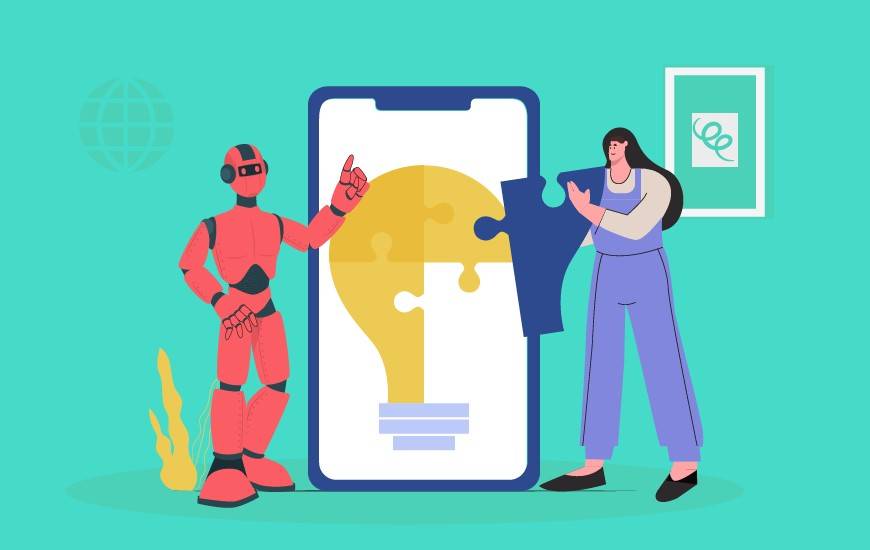Machine Learning (ML) and Artificial Intelligence (AI) are the two terms people most probably talk about the most. Now, as we know that Artificial Intelligence is expanding its coverage with a rapid speed, the adoption of ML has to increase simultaneously. Machine learning algorithms is, as the name suggests, a process where AI learns the data. It’s a branch of AI and helps in improving the knowledge of AI so it can work with better efficiency.
For example, ML helps AI in collecting the data such as pronunciations, dialects, vocabularies, and more to help in understanding voice commands more. In the case of writing, apps such as Grammarly are feeding their AI language data to help users in improving their writing skills. Just like that, if you look around, you will find plenty of examples of ML affecting our lives almost every day.
You can also take a Statista report for reference. As per this Statista report, in 2021, 57% of AI and ML use cases were based on improving the customer experience. While generating customer insights had 50% of all use cases in the same year.
Top ML algorithm trends to look out for and beyond
Moving forward, in this blog, we are discussing a few crucial ML algorithm trends that we might see getting common in 2022 and beyond. So, if you are intrigued enough, stay with us until the end of this blog.
So, without further ado, let’s begin!
1. Auto ML
As the name gives it away, among all types of machine learning algorithms, Auto Machine Learning is much easier to upgrade. Auto ML is used to label the data to categorize it automatically. The purpose is also to ensure that AI app development requires less cost, coding, and resources. There are templates that Auto ML focuses on providing. These templates are designed to ensure that the dependency on ML experts is reduced. In 2022, with Auto ML, we might see the origin of new apps with AI being a common culture among them.
2. Code-free ML
As the name suggests, these types of algorithms will rule the world of machine learning trends in near future. No-code ML or Code-free ML is used to eliminate the long route that includes algorithm designing, pre-processing, retraining, data collection, and more to build a proper AI solution.
No-code ML will help users in deploying quick solutions with the minimum possible cost. The process of designing algorithms will require drag and drop, so developers will be able to use this technique conveniently.
3. ML and IoT combinations
AI-supported IoT Solutions have already started existing in the form of robots, vehicles, traffic monitoring systems, and more. However, with upgrading Machine Learning algorithms, these trends are surely getting upgraded in parallel. Increasing ML and IoT capabilities can help in more efficient solutions in the future. For instance, algorithms can be used to collect data such as weather patterns, the impact of global warming, and more to prepare solutions. This can work for multiple industries including operational, fuel, electricity, and more.
4. Full-stack deep learning
In simple terms, full-stack deep learning is designed to support developers in training developers so that they can build AI libraries by taking business needs into consideration. The goal is to help developers in building ML infrastructure that can be deployed into multiple markets with multiple business needs.
5. ML process without human interference
Unsupervised ML algorithms are evolving in the industry to create solutions that do not require any manual data feeding or human supervision. Unsupervised ML algorithms can prepare reports that are not labeled but based on their own understanding of the data they picked. In tasks such as identifying alternate solutions, research patterns, and more, automated ML can be really impactful.
6. Tiny ML
Tiny ML is generally an idea for small IoT-supported devices. These devices can work with a slower network and power to process small amounts of ML data. Now that IoT devices are already supporting blockchain benefits, ML can be used to create a server connected with multiple small IoT devices for purposes such as security and more. Data collected by ML can help in a rapid improvement of security methods by using AI too.
Conclusion
Just like its results and their quality, ML is an evolving technology. Its algorithms get smarter with each discovery data scientists make. Thus, apart from these trends that we are expecting to become common, we might witness some additional innovations getting common by the end of the year. However, there are some industries such as customer service, healthcare, IoT, AI, app development, and more that will surely find new ways of using ML algorithms by modifying them. So, with hopes that apart from all upgrades, we see some amazing new innovations just like we saw Metaverse for ML solutions too.




